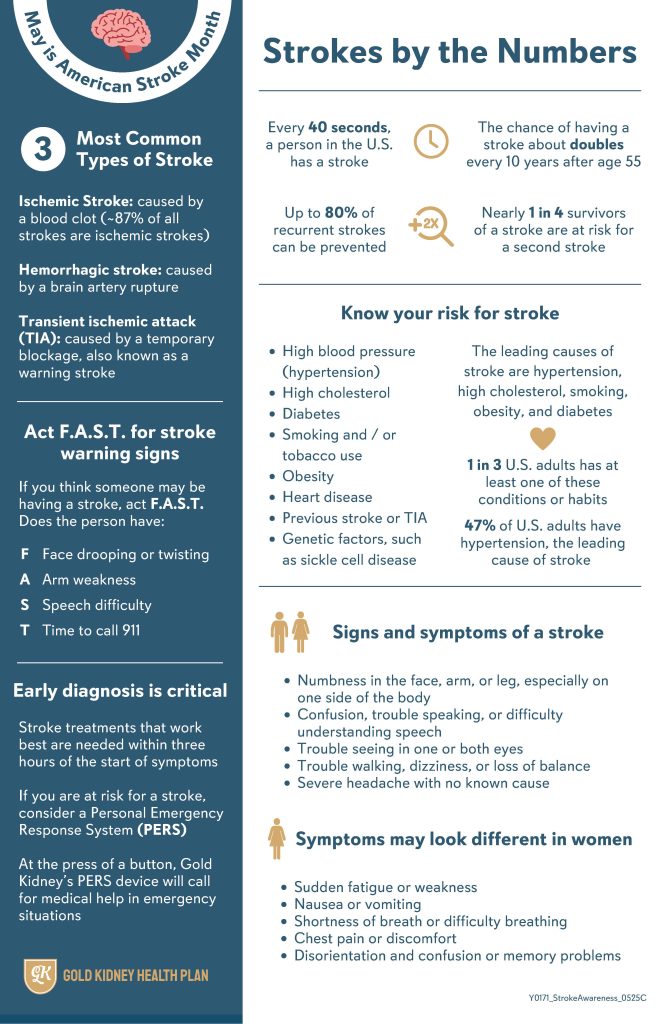The month of May is an important time for health education. This month, the American Heart Association encourages communities to dedicate awareness for stroke and high blood pressure education.
Each year, nearly 800,000 people in the United States have a stroke[1], and almost half of adults have high blood pressure, one of the leading causes of stroke[2]. Strokes are medical emergencies that need immediate attention. Knowing the signs of a stroke and what action to take in the case of an emergency can save a life.
Understanding Strokes
A stroke is caused when blood flow to the brain is interrupted. This happens when blood carrying oxygen and nutrients to the brain is blocked or when a blood vessel ruptures in the brain. Strokes can happen to anyone at any age, but many strokes are considered preventable. This is why the best thing you can do for your health is to learn the risk factors for a stroke and how to identify when one is happening.

Being Prepared Can Save a Life
Every minute counts when it comes to receiving effective treatments for a stroke. Recognizing signs of a stroke and seeking medical help quickly can make all the difference in recovery.
At Gold Kidney Health Plan, we know how important it is to help our members protect their health. We’re proud to offer a Personal Emergency Response System (PERS) as a valuable health plan benefit. In the event of an emergency, the wearable PERS device connects members to trained professionals at the click of a button. Learn more about our PERS device and our many other health plan benefits by visiting our Supplemental Benefits page, here.
Explore our 2025 plans to learn more about our health plans and benefits.
Y0171_Blog_StrokeAwareness_0525C
Infographic Transcript
3 Most Common Types of Stroke
- Ischemic Stroke: caused by a blood clot (~87% of all strokes are ischemic strokes)
- Hemorrhagic stroke: caused by a brain artery rupture
- Transient ischemic attack (TIA): caused by a temporary blockage, also known as a warning stroke
Act F.A.S.T. for stroke warning signs
If you think someone may be having a stroke, act F.A.S.T. Does the person have:
Face drooping or twisting, Arm weakness, Speech difficulty? Time to call 911.
Early diagnosis is critical
Stroke treatments that work best are needed within three hours of the start of symptoms. If you are at risk for a stroke, consider a Personal Emergency Response System (PERS). At the press of a button, Gold Kidney’s PERS device will call for medical help in emergency situations.
Strokes by the Numbers
- Every 40 seconds, a person in the U.S. has a stroke
- The chance of having a stroke about doubles every 10 years after age 55
- Nearly 1 in 4 survivors of a stroke are at risk for a second stroke
- Up to 80% of recurrent strokes can be prevented
Know your risk for stroke
- High blood pressure (hypertension)
- High cholesterol
- Diabetes
- Smoking and / or tobacco use
- Obesity
- Heart disease
- Previous stroke or TIA
- Genetic factors, such as sickle cell disease
The leading causes of stroke are hypertension, high cholesterol, smoking, obesity, and diabetes. 1 in 3 U.S. adults has at least one of these conditions or habits. 47% of U.S. adults have hypertension, the leading cause of stroke.
Signs and symptoms of a stroke
- Numbness in the face, arm, or leg, especially on one side of the body
- Confusion, trouble speaking, or difficulty understanding speech
- Trouble seeing in one or both eyes
- Trouble walking, dizziness, or loss of balance
- Severe headache with no known cause
Symptoms may look different in women
- Sudden fatigue or weakness
- Nausea or vomiting
- Shortness of breath or difficulty breathing
- Chest pain or discomfort
- Disorientation and confusion or memory problems
[1] https://www.cdc.gov/stroke/data-research/facts-stats/index.html
[2] https://www.heart.org/en/health-topics/high-blood-pressure/the-facts-about-high-blood-pressure





